religious / missions codes telegraphic codes, main
The codes described here concern religious and missionary administration, and publishing. Hallner’s Scientific Dial Primer (1912) and Cole’s Complete Code for Metaphysicians are not administrative in nature, and might fairly be described as idiosyncratic.
upper vertical bar ╹ at left returns to top of page; lower ╻ goes to main telegraphic codes and message practice page.
| 1853 | Traveler’s Vade Mecum A. C. Baldwin, comp. (Clergyman’s Department pp 25-28, and passim) |
| 1911 | Telegraphic code American Baptist Foreign Mission Society (Boston) |
| 1912 | The Scientific Dial Primer Andrew Hallner, comp. |
| 1913 | China Inland Mission Private Telegraph Code (Shanghai) |
| 1921 | The Missions Code Charles L. Boynton, comp. (copyright 1915; 1921, 1930 printings) |
| 1923 | Cole’s Complete Code for Metaphysicians Willis Vernon Cole, comp.; Christian Science) |
| 1925 | The Salvation Army Telegraph Code No. 2 |
| 1926 | Private Telegraphic and Cable Code (The First Church of Christ, Scientist) |
| 1853
The Traveler’s Vade Mecum, A. C. Baldwin, compiler.
NYPL copy/scan, via hathitrust : link description : |
A fuller discussion of this code and its remarkable author Abraham Chittenden Baldwin (1804-1887) can be found at this separate page : link.
| 1911
Telegraphic Code, American Baptist Foreign Mission Society. Columbia University copy/scan, via archive.org : link description : The codewords are (with exception of p 15, Code Table for Dates, which is used with permission from The Adams Cable Codex!) “bona fide Latin words of not more than ten letters each.” |
Name stamp of “CHARLES L. BOYNTON” appears on Private G. Y. X. Condensing Table, between the code pp 1-23, and a Supplement code pp25-28 devoted to Conference and Committee matter
Charles Luther Boynton (1881-1967)
biography in the finding aid to MRL6 Charles Luther Boynton Papers, 1807–1976
The Burke Library at Union Theological Seminary, Columbia University
link (pdf; accessed 8 November 2023)
and more at the Hoover Library (Stanford University) : link (accessed 8 November 2023)
Boynton was active in missionary affairs and the YMCA, and was interned in Shanghai during the Japanese occupation.
Moreover, Boynton compiled the The Missions Code (1915), described further below. The biography in the MRL 6 (UTS/Columbia) finding aid concludes thus :
“Boynton returned to the United States in 1946, and lived in Claremont, California. He continued to work on the history of Protestant Missionary Work in China, in addition to organizing autobiographical material. In his retirement, Boynton chose a new branch of interested every 5 years — maps, coins, guide books, music and international stamps, to name a few — and pursued this hobby with vigor. He read constantly, belonging to several book clubs at the time. He once estimated that he purchases approximately 200 books per year for over 40 years, giving most of them away after he had read them...”
aside —
presumably Boynton would have known D. Willard Lyon (1870-1949), Y.M.C.A. head in China, who also retired to Claremont. See brief discussion of Lyon (father of journalist Jean Lyon, 1902-60) at page devoted to her writing (and life) : link
| 1912
The Scientific Dial Primer, Containing universal code elements of universal language, new base for mathematics, etc. Andrew Hallner, comp. UC Berkeley copy/scan, via archive.org description : 157 + (3 table of contents, and index)
“The Scientific Dial contains: |
The Scientific Dial Primer is an idiosyncratic work of speculative coding, rather than a practical or even prototype telegraphic code. I see in it two main aspects and perhaps motivations: an interesting dial cipher system, and a phrase vocabulary that, in its exposition, ultimately takes leave of the code and becomes an independent work of episodic fiction. The first third of the book is devoted to the code/condenser, and its uses; the balance of the book is devoted to edifying and moralistic exchanges, imagined conversations, etc., under the headings “Code Department,” “Travelers Code,” “Lovers’ Code,” “Leap-Year Code,” and “Greetings.”
The Dial itself is an “evolution” from the traditional clockface, a universal language understood by all. It is “an indicator of time on a somewhat difference scale, also of quantity and quality, and also delving into mathematics and language.” (p7)
It involves Five Radial Grand Divisions, a, e, l, o and u. These subjoin to one of 25 letters (excluding a) in the outer ringt, to yield ba, ca, da, be, ce, bu through yu — 100 figure values in all.
So far, the dial is something like a figure > letter condenser.
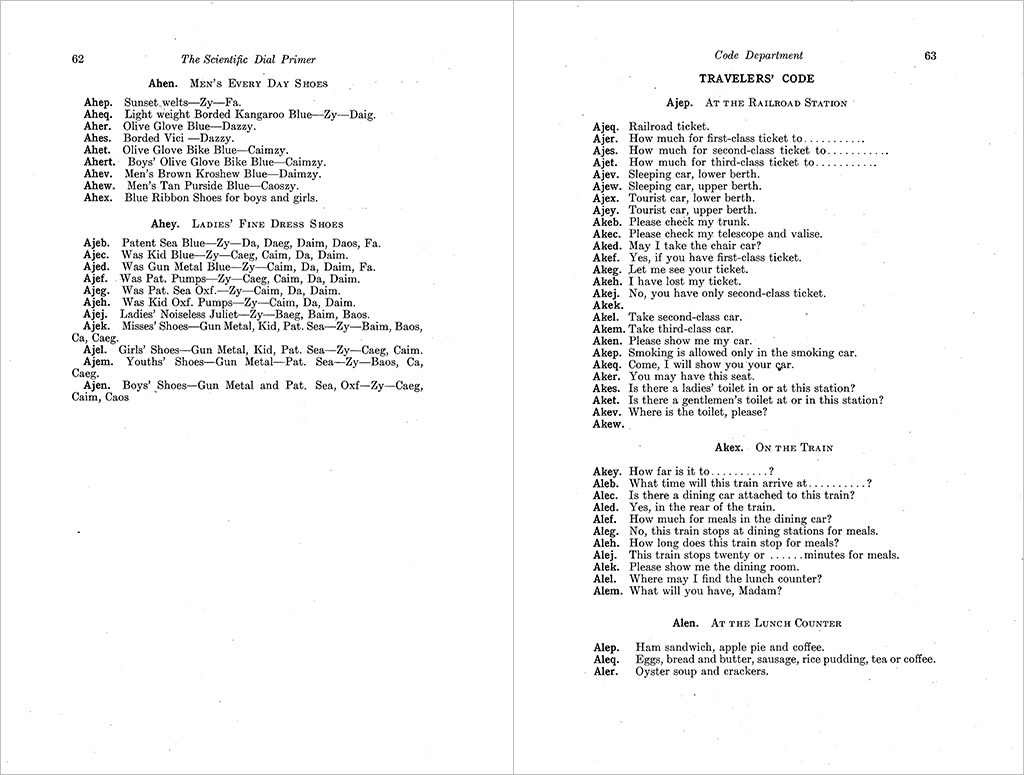
⬆
pages 62-63, Andrew Hallner, The Scientific Dial Primer (1912); from photocopy of LC copy
In these pages (62-63, 66-67), simple code vocabulary gives way to conversational, homiletic sketches, some of these extended over several pages.

⬆
pages 66-67, Andrew Hallner, The Scientific Dial Primer (1912); from photocopy of LC copy
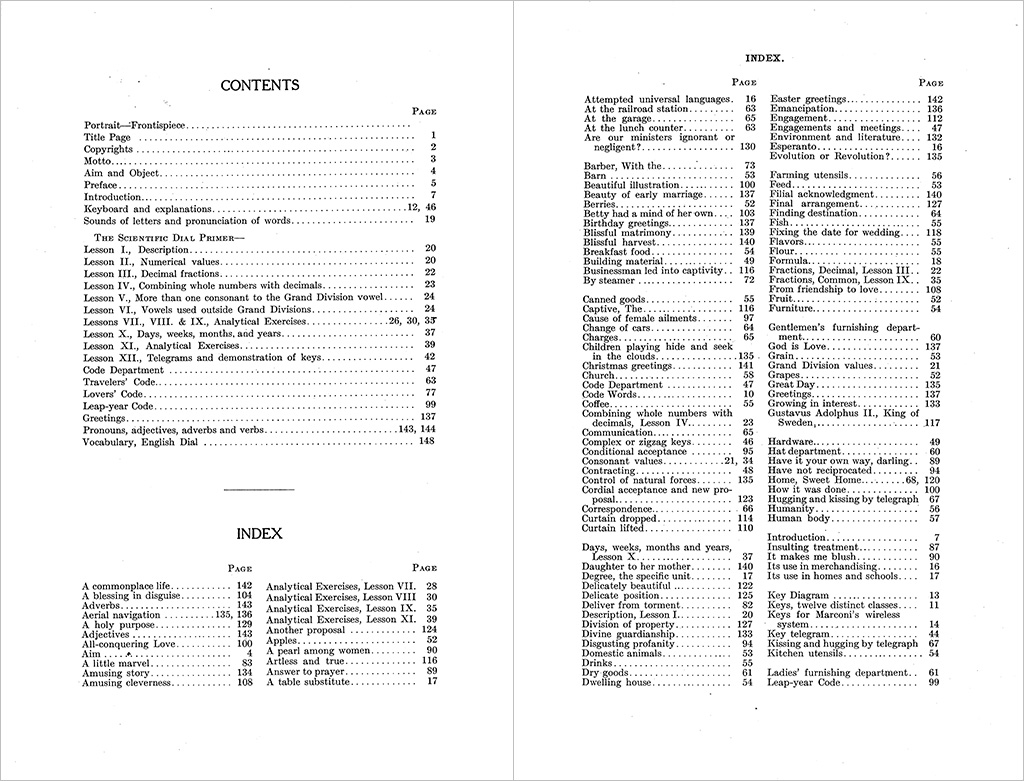
⬆
TOC and index, Andrew Hallner, The Scientific Dial Primer (1912); from photocopy of LC copy
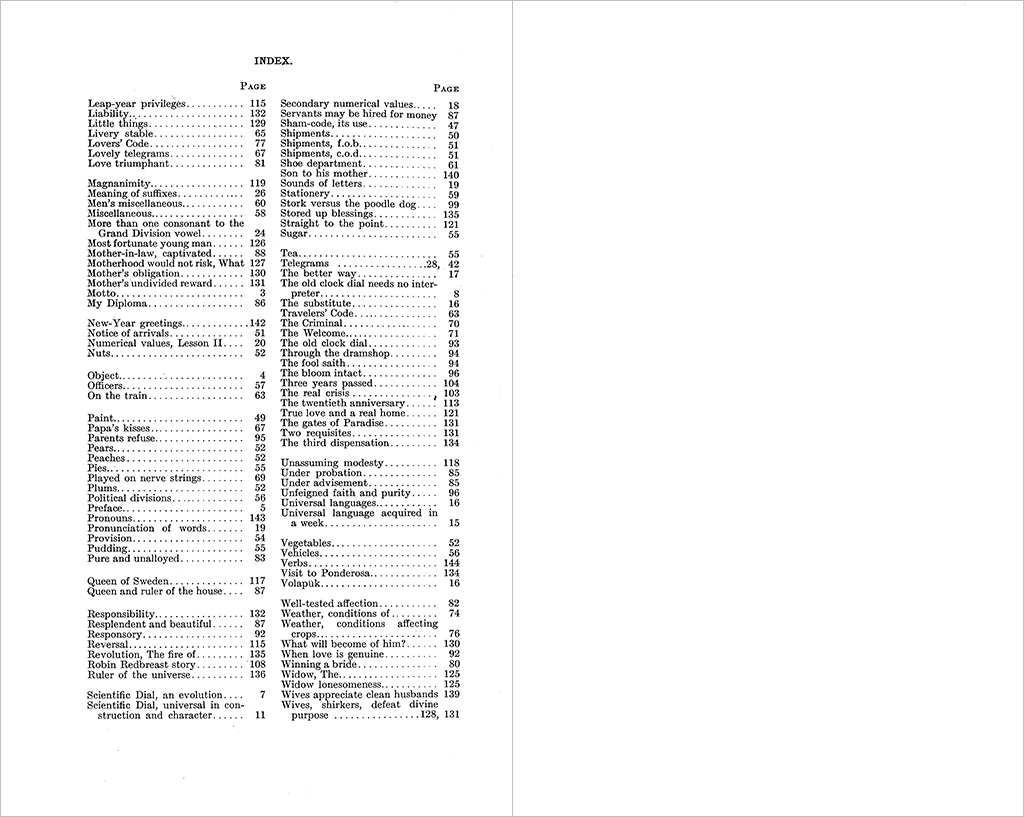
⬆
Index, Andrew Hallner, The Scientific Dial Primer (1912); from photocopy of LC copy
The heterogeneous nature of the content, can be discerned from the alphabetically-ordered index entries. One imagines the delight that Hallner might have taken, in compiling this thing!
Hallner (1846-1930) and his wife Ida had seven children — three sons and four daughters — and this reader suspects that a number of the photographs reproduced in the book, are of those children. At the time this code appeared, Hallner was 65 years old. He’d been a pastor in Nebraska and editor of a Swedish newspaper in Chicago. He served as the first pastor of a Swedish Evangelical church in Swedeburg (Nebraska? California), in 1876-86; he later lived in Kingsburg and in Turlock, California. A biographical sketch is found in George H. Tinkham, History of Stanislaus County California: With Biographical Sketches (1921), here.
N. Katerine Hayles examines Hallner’s Scientific Dial Primer in Chapter 5 (Technogensis in Action: Telegraph Code Books and the Place of the Human), pp 163-170 of her How We Think : Digital Media and Contemporary Technogenesis (2012). Hayles understands this code as an instance of the tensions between “the dream of a universal language and ‘neutral’ scientific code,” on the one hand, and the plaintext particular. (She mentions Lev Manovich’s characterization of narrative and database as “natural enemies.”)
I view the Scientific Dial Primer not as a failed (or necessarily weird, or bizarre) telegraphic code, but rather as a work of imaginative literature, and even a memoir/family album, that starts out as a code (or condenser) but takes leave of that form in short order.
Hallner also authored Uncle Sam, the teacher and the administrator of the world. Sacramento, Cal.: The News. Pub. Co., 1918. : link
| 1913
China Inland Mission Private Telegraph Code. Second Edition.
Cornell (Wason Collection) HE7679.C53 copy/scan, via archive.org : link description : 1-xii, 2-443 |
“Since the year 1899 a small Code, compiled by Mr. T. G. Willett, which was based upon the telegrams received at, and despatched from, the Mission Headquarters in Shanghai, during a period of more than ten years, has been of much service.” (from preface dated 1907). Typically, the code is extrapolated from archived messages, with continuing collation of new matter.
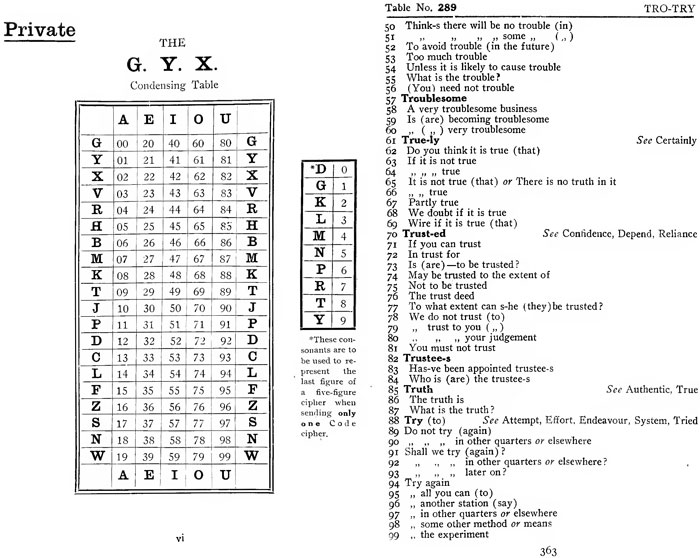
⬆
composite of condenser (p. iv) and p 363, China Inland Mission Private Telegraph Code (1913).
Using the above, to send only one codeword from Table No. 289 at right — “28987 / What is the truth?”, one would write KE (28) NU (98) and R (7) — KENUR.
Preceded by a Private Telegraph Code published in Shanghai in 1907, this volume was consulted in preparation of The Missions Code in 1930, by the Foreign Missions Conference of North America. The 1930 code incorporates the five-letter principle rather than a condenser, and offers an enlarged vocabulary.
| 1921
The Missions Code Editor, Charles L. Boynton, B.A.; description : n.b. : 1921.
NYPL copy/scan : link U Chicago (John Crerar Library) copy : link Columbia University (Union Theological Seminary) copy/scan, via google books : link 1930 |
includes much “introductory” matter for non-specialists, including an “example of preparing message to send” in which :
“A missionary’s wife is ill and the doctors recommend immediate return home. The station is understaffed and a substitute must be called to take the place of the missionary. He must communicate the facts to the Board and learn their wishes in the case.
There are three main ideas. (1) Return on account of ill health of wife, (2) A substitute or relief or help is needed, (3) Will the Board make these possible?”
There follows an explanation of how to express these ideas using available phraseology, within cabling regulations.
The “introductory” pp iv-vii provides a good survey of the kinds of codes in existence, the evolving nature of their codewords, etc.
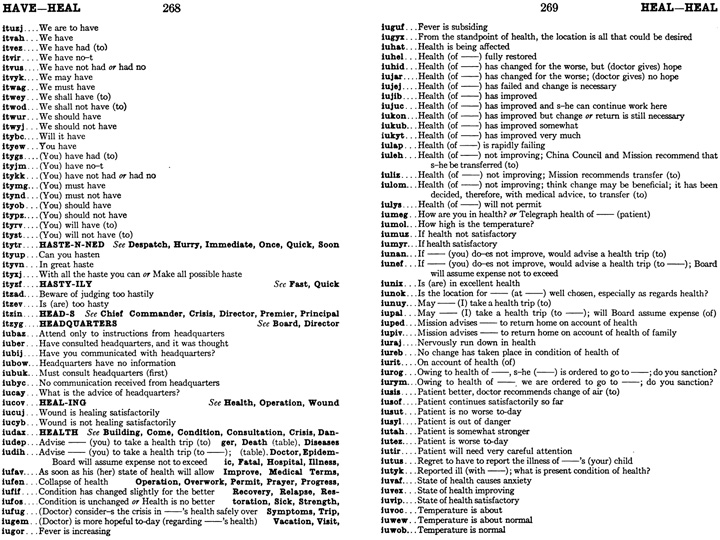
⬆
pp268-69, The Missions Code (1921)
The specimen pages shown above are typical; note cross-referencing (in boldface).
| 1923
Cole’s Complete Code for Metaphysicians / Privacy Efficiency Accuracy Economy description : Five letter, bilingual (English/French) code. |
I did not know that Cole was a practitioner of Christian Science, when I examined this code at LC so many years ago. Fortunately, it was short — and interesting enough — that I photocopied it in its entirety. The vocabulary consists of groups of 4, 6, 8, 12 phrases under single headings. In many instances, the last one or two of the phrases are philosophical/theological. See below.
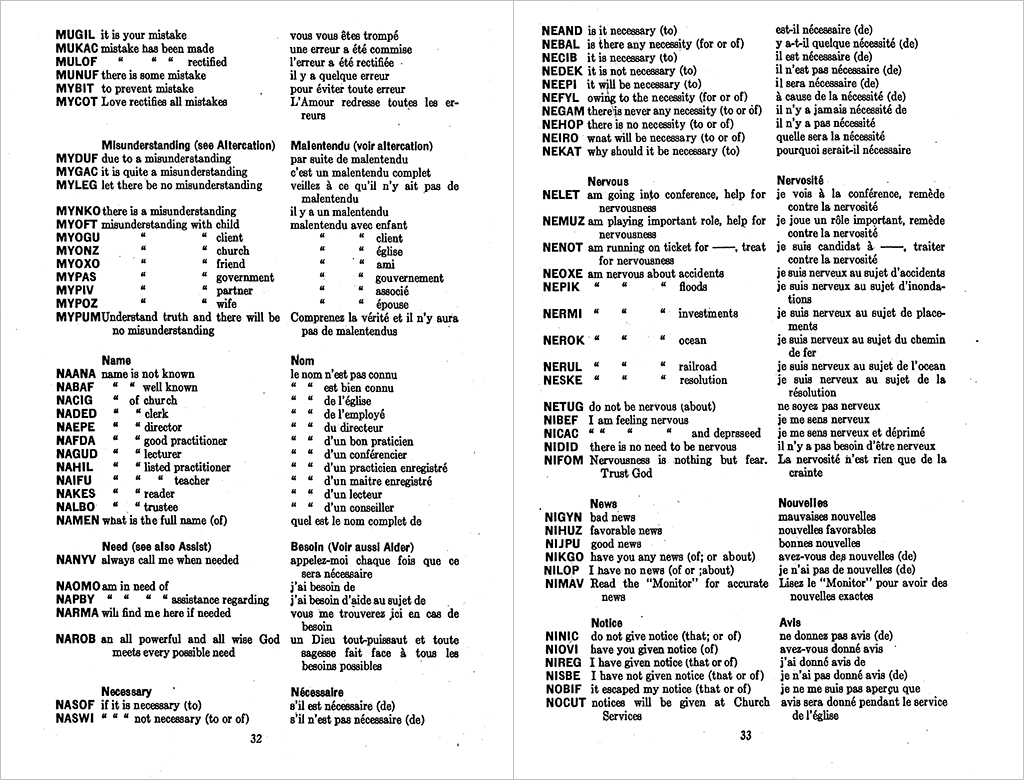
⬆
Pages 32-33, Cole’s Complete Code for Metaphysicians (1923)
Cole wrote several books of poetry. See for example Our Leader, and Other Poems (1907), e.g., “Love”, here. His best collection of poetry is, arguably, this telegraphic code. Contents (and selected page spreads) as follows —
Forward (English) pp2-3
Forward (French) pp4-5
Introduction (English) pp6-7
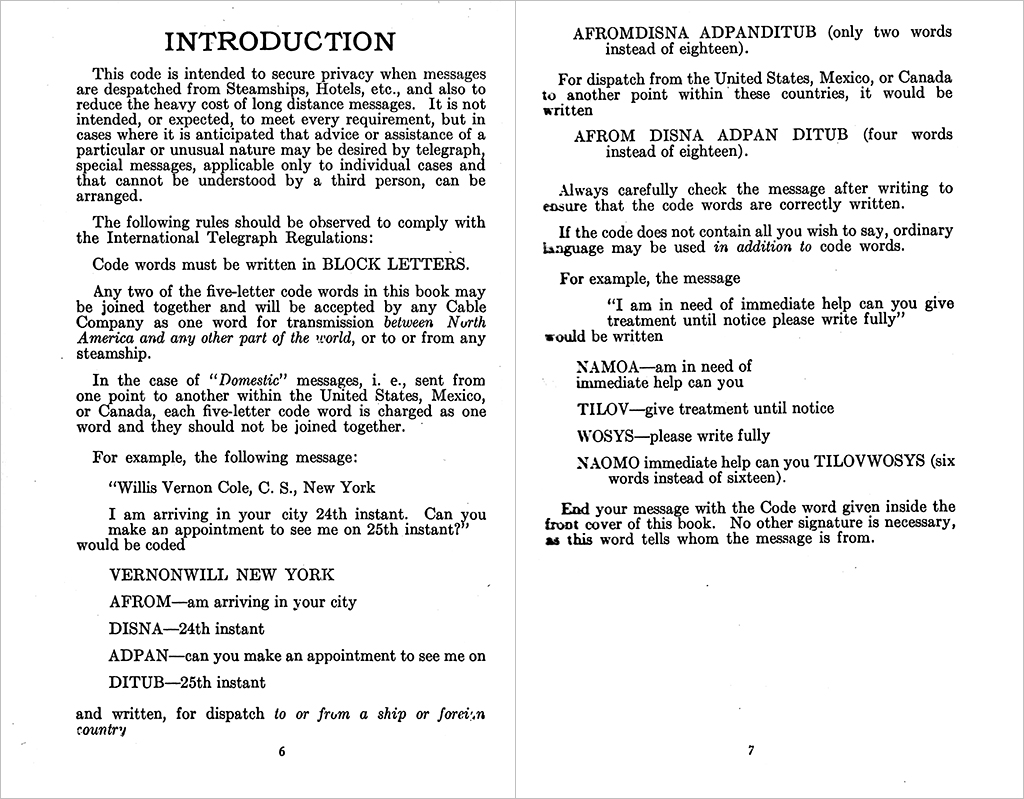
⬆
Pages 6-7, Cole’s Complete Code for Metaphysicians (1923)
Note how the code is pitched to Cole’s practice as a meta-physician.
Introduction (French) pp8-9
main vocabulary (two-columns, English and French each page) pp10-48
phrases concerning illness (and "C.S." treatment) pp49-56 (again, bilingual)
decoding section (for French, in alphabetical order) pp 57-89
page, line and verse references to Bible, also works of Mary Baker Eddy, and other books, pp90-96 (with instruction for use, in English and French, on p96)

⬆
Pages 46-47, Cole’s Complete Code for Metaphysicians (1923)
The section on treatments (pp49-56) includes both medical and mental ailments; all are, “from the absolute point of Christian Science,” viewed as “errors of the human mind — hence unreal.”
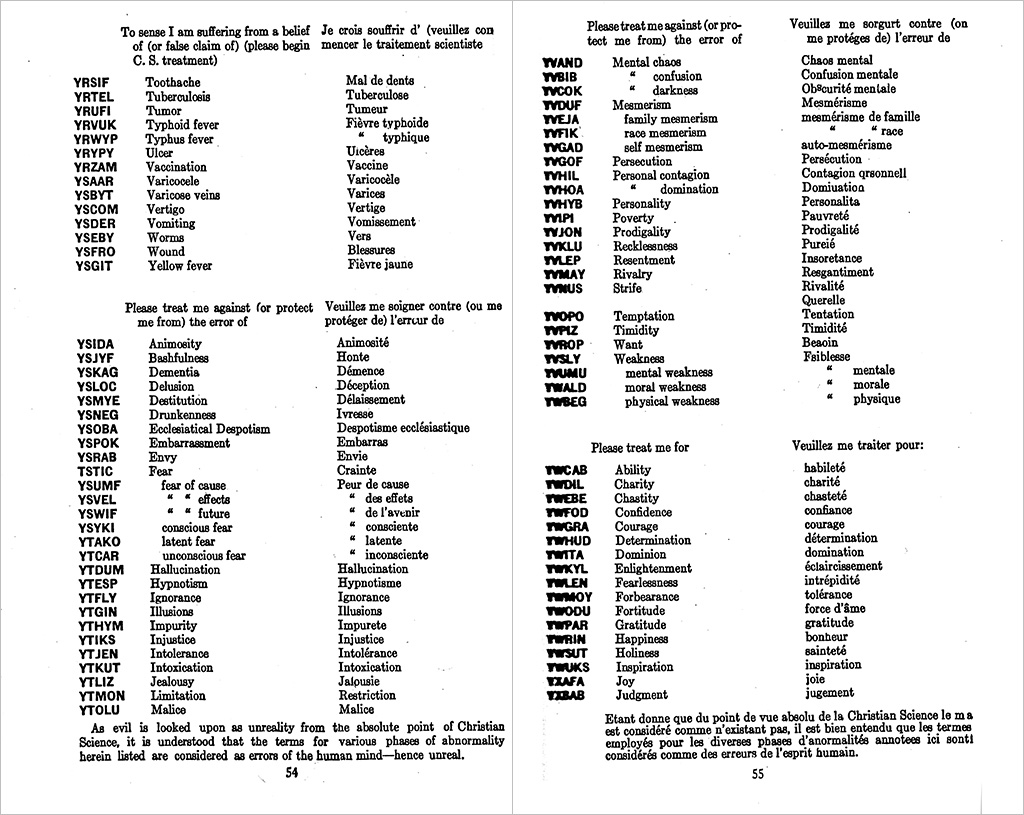
⬆
Pages 54-55, Cole’s Complete Code for Metaphysicians (1923)
comments
Willis Vernon Cole (1882-1939) was a practitioner of Christian Science, poet, vintner; lived in France in late 1920s until his death. See the useful if hagiographic entry at wikipedia — Cole’s publishings are still widely distributed and can be found in the libraries and classrooms of such colleges as Yale, Harvard, Brown etc.
| 1925
The Salvation Army Telegraph Code No. 2 description : cover measurement: 5 inches wide, 7 1/4 high private collection |
more? (discussion of other Salvation Army codes?)
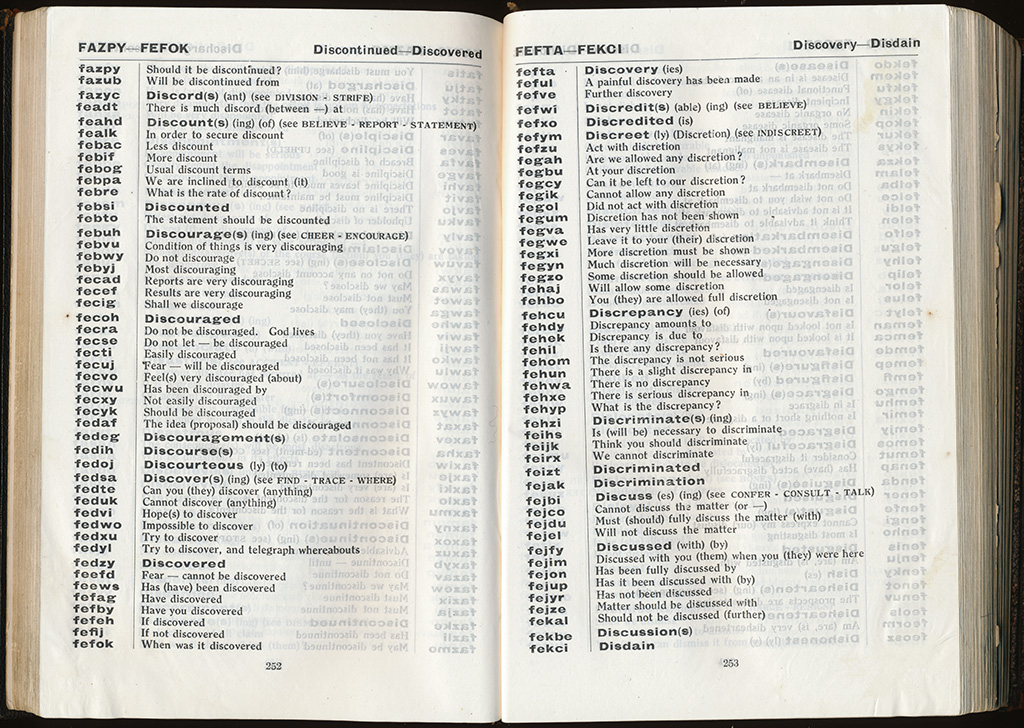
⬆
pages 252-253, The Salvation Army Telegraph Code No. 2 (1925)
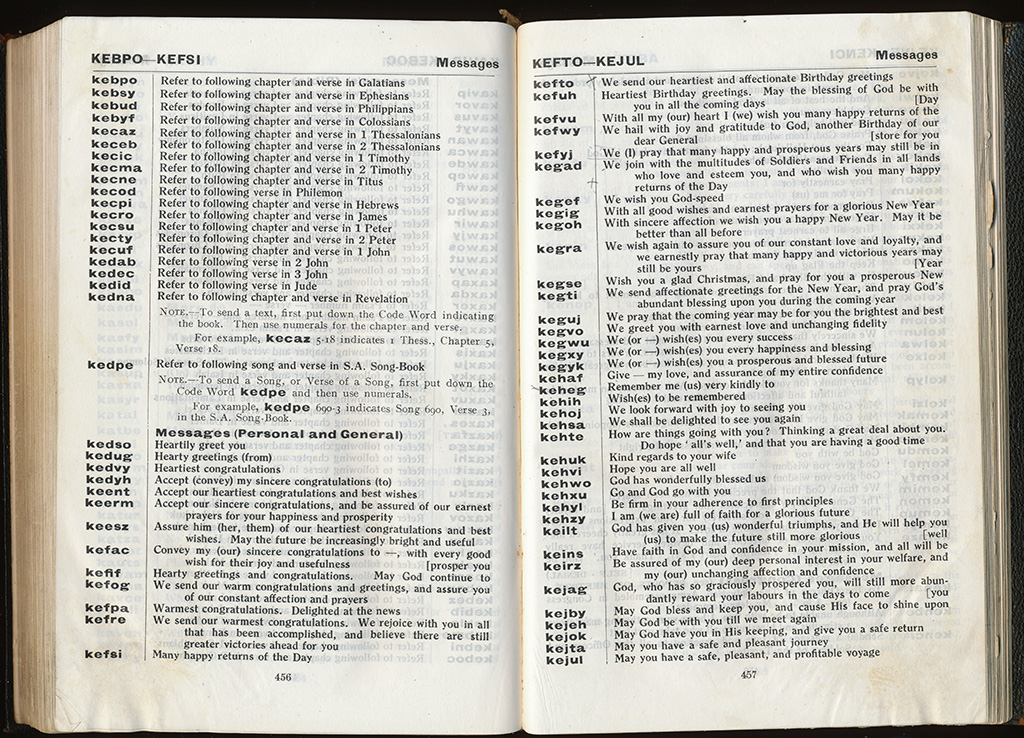
⬆
pages 456-457, The Salvation Army Telegraph Code No. 2 (1925)
Pencil marks (on these and other pages in this copy), as received. This copy was issued to The Territorial Commander, Western Territory, U.S.A. (slip pasted onto halftitle page).
There are several sections for messages —
- Personal and General pp 456-458
- Congress (with note “see Reports of Meetings”) pp458-461
- Congress Responses pp461-463
- Sympathy pp463-464
Note also the end of section Message(s) (Bible), which is found in some other telegraphic and private codes.
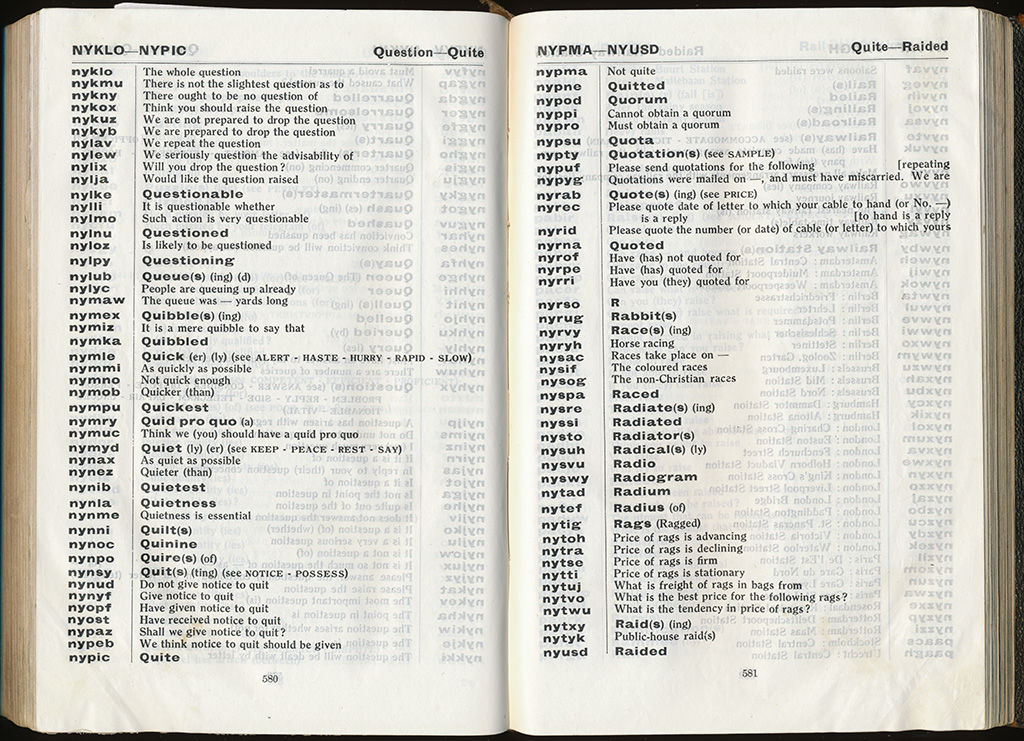
⬆
pages 580-581, The Salvation Army Telegraph Code No. 2 (1925)
Phrases regarding the price of rags have to do with paper manufacture?

⬆
pages 610-611, The Salvation Army Telegraph Code No. 2 (1925)
Reports of meetings would have been source for various Salvation Army publications, including War Cry.
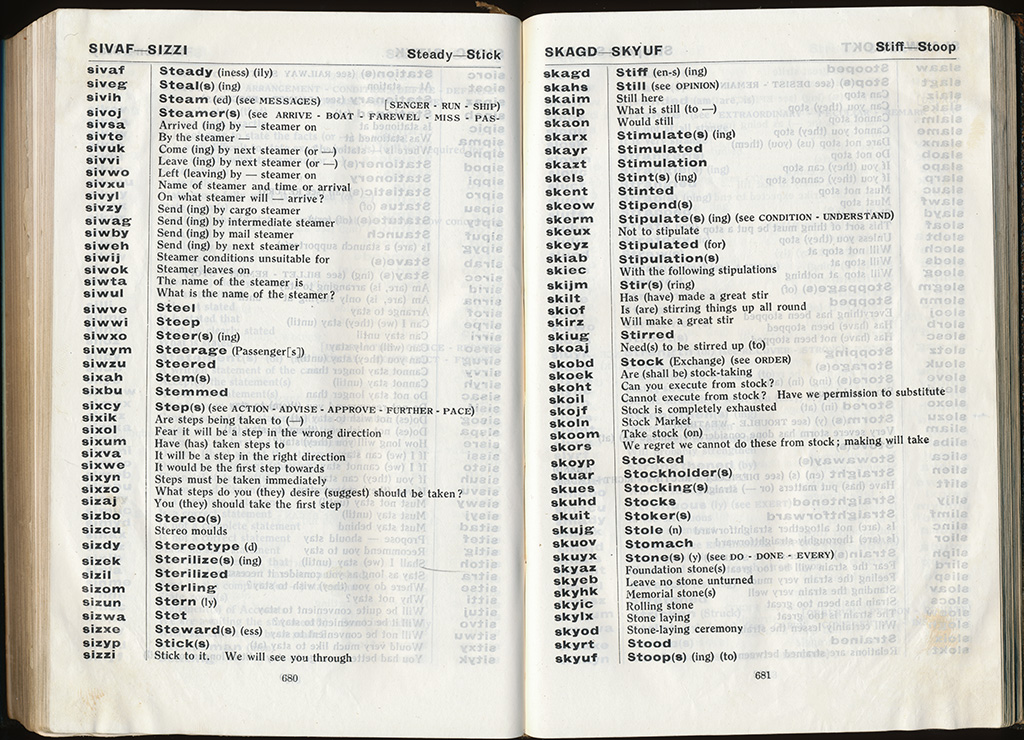
⬆
pages 680-681, The Salvation Army Telegraph Code No. 2 (1925)
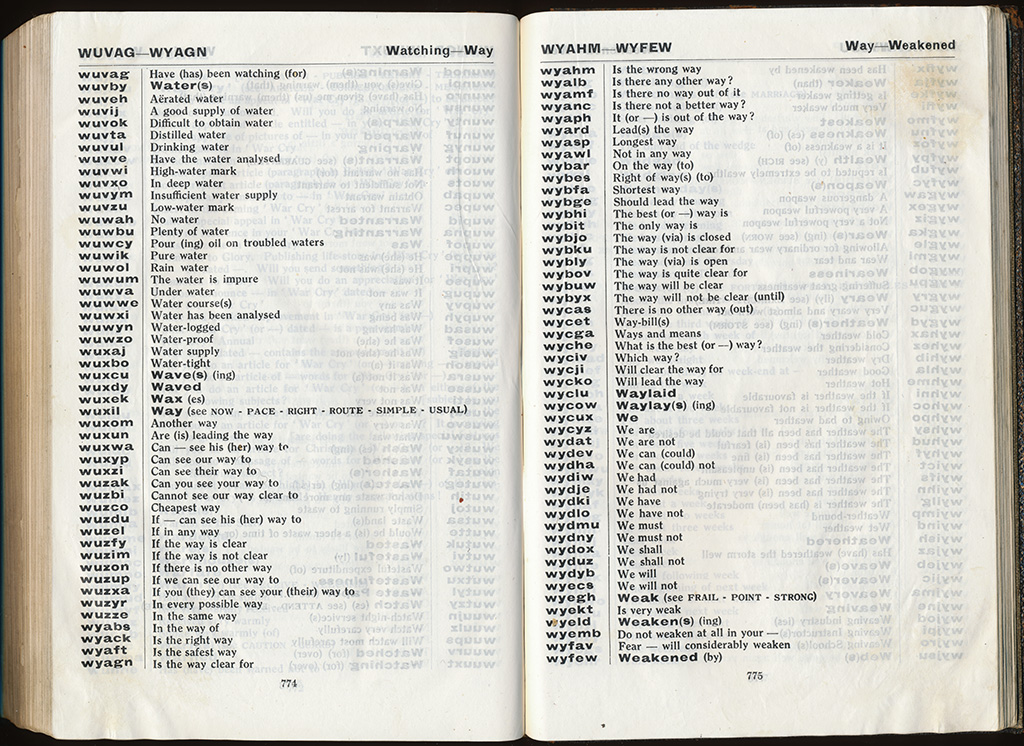
⬆
pages 774-775, The Salvation Army Telegraph Code No. 2 (1925)
references
- A Salvation Army Heritage Centre blog post reports that five editions of the SA Telegraphic code are in its archives, dating from 1910-1946. The article now can be found only via thewaybackmachine, ca 2008 : link.
- Wesley Harris describes The Salvation Army General Telegraphic Code (1910) in his possession
here
originally in Journal of Aggressive Christianity 40:256 (December 2005 - January 2006): 50 - Warren L. Maye. "R u redy 4 ths?" Good News! 28:2 (March 2011) : 2
ebsco abstract —
The article reports on the conversion of the entire Contemporary English Version of the Bible to short message service (SMS) data application by the son of an employee of the Bible Society in Australia. According to Michael Chant, Bible Society spokesperson, the SMS version of the Bible enhances the evangelistic mission of the Church. It also discusses the Salvation Army Telegraph Code which uses ciphers to make messages confidential.
accessed 12 July 2015
| 1926
Private Telegraphic and Cable Code description : 5L, Abaab, Abade, Abaef > Ahyut photocopied from LoC copy HE7677.C45 B6 1926; |
Devoted to publishing. Headings as below, with specimen code/phrase pairs.
- Advertising p7
- Banks p7
- Works of Mary Baker Eddy (pp 8-15; titles, bindings, various languages available; here as elsewhere in this code, ample blanks)
Abusm / Personal Contagion, What Our Leader Says (paper
Abuyt / What Our Leader Says (vest pocket folder) - Periodicals p15
- General Publications and Miscellaneous Products of The Christian Science Publishing Society p16
- Bibles p21
- Bible Concordances p23
(various bindings of Oxford Cyclopedic, Strong's Exhaustive, Walker's Comprehensive and Young's Analytical - Names (pp24-29)
- Manual References p29
- Committee on Publication Messages p30
Afsat / Please investigate and report the facts re-
Afsex / The statements which you have inquired about (or which are otherwise designated) are substantially correct.
Afsha / The statements which you have inquired about (or which are otherwise designated) are false.
Afsib / Have you seen article in ———?
Afsle / The Chicago Tribune of ———
Afsoh / The New York Times of ——— - Reading Rooms
- Standing of Members p32
Afxay / Is the following member in good standing?
Afxec / Is the following a trustworthy person
Afxig / Can the following be relied upon?
Afxom / The person mentioned is a member in good standing
Afxro / The person mentioned is not in good standing
Afxus / The person mentioned is a trustworthy person
Afyaz / The person mentioned is not a trustworthy person
Afyed / The person mentioned can be relied upon
Afyih / The person mentioned cannot be relied upon - Board of Directors' Messages
- Titles, Officials, Departments, Personnel, etc.
- Branches of The Mother Church and Distribution Committees
- Street Addresses
- Accounts and Audits
- Correspondence
- Galley Sheets
- Journal Cards
- Orders and Subscriptions
- Shipping
- Copyright Messages
Ahwyv / Copies for copyrighting shipped today
Ahxay / Have you received copies for copyrighting?
Ahxec / Copies for copyrighting not received
Ahxig / Copies for copyrighting received and everything ready for action on date set
Ahxom / Are you prepared for copyrighting on date set?
Ahxro / Postpone date of copyrighting to ——— (follow code word with new date for action)
Ahxus / Postpone date of copyrighting until further notice
Ahyaz / Copyright action has been postponed as directed
Ahyed / Copyright action has been completed
Ahyih / Follow advice of local attorney as to copyright question which you have presented - Registered Cable Addresses for The Mother Church, Branches, Distribution Committees, etc.
20150718 / 20231109